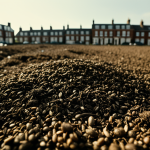Key secrets to crafting a creamy bread and butter pudding
Achieving a creamy bread and butter pudding hinges on three main secrets: ingredient quality, the right ratios, and precise technique. First, use fresh, thick-sliced bread such as brioche or challah. These breads absorb custard well, contributing to that luscious creaminess.
Balancing the custard is crucial. Mixing whole milk with heavy cream creates a richer texture without overwhelming heaviness. Eggs provide structure and silkiness; too many, however, can lead to curdling, so expert secrets recommend using around three large eggs per 500ml of liquid.
In the same genre : What are the steps to making a homemade spotted dick pudding?
For technique, soak bread slices well but avoid sogginess by letting excess custard drip off before layering. Patience during baking matters: moderate oven temperatures allow gentle cooking. Rushing this can cause a dry, dense pudding rather than a velvety one.
Finally, layering bread evenly ensures each bite soaks in just the right amount of custard. Mastering these tips and expert secrets guarantees that signature, creamy texture beloved in bread and butter pudding.
Also to discover : How can you master the art of making a traditional English breakfast?
Optimal ingredients and ratios for creaminess
Selecting the right ingredients is key to crafting a creamy bread and butter pudding that sings with richness. Brioche or challah are the expert-recommended breads due to their soft texture and slight sweetness, absorbing custard evenly without falling apart. White bread works, but it lacks this depth.
Balancing milk and cream forms the backbone of your custard. Tips from seasoned bakers suggest a ratio of two parts whole milk to one part heavy cream. This ratio achieves the perfect silkiness without making the pudding overly heavy or greasy. Adding too much cream can weigh the dessert down, while too little risks dryness.
Egg quantity critically affects texture; using roughly three large eggs per 500ml liquid strikes the ideal balance. Eggs provide structure and silkiness but excess causes curdling or an overly dense feel. Sugar levels also influence not just sweetness but custard consistency—too much can alter the texture, so moderate amounts resembling 50-70g per 500ml liquid work best.
Together, these ingredient choices and ratios are the foundation for that sought-after luxuriously smooth, creamy bread and butter pudding.
Step-by-step guide to the perfect custard base
Creating a creamy bread and butter pudding starts with mastering the custard base. Precise mixing is essential to avoid scrambled eggs and ensure a smooth texture. Begin by gently whisking eggs with sugar until pale, then gradually incorporate warm milk and cream to temper the eggs. This slow process prevents curdling and builds a silky custard.
Infusing flavors at this stage enriches every bite. Vanilla pods or extract and citrus zest, like orange or lemon, elevate the base with subtle complexity. For a twist, some expert secrets include soaking dried fruits in alcohol before adding to the custard. This adds depth and luxury without overpowering creaminess.
Soaking bread slices demands attention. Dip each slice thoroughly but allow excess custard to drip off before layering. Too much custard saturates bread unevenly, ruining texture. Layer bread evenly in the dish for consistent soaking, ensuring every bite is moist yet holds shape.
Following these tips carefully transforms simple ingredients into a luscious, creamy bread and butter pudding that embodies expert craftsmanship.
Common mistakes and how to avoid them
Avoiding common mistakes is crucial to preserving a creamy bread and butter pudding texture. One frequent error is overbaking, which causes liquid to evaporate and results in a dry, dense pudding. To fix this, bake at moderate temperatures and test doneness by gentle jiggle—custard should be set but slightly wobbly.
Another pitfall is an incorrect bread-to-liquid ratio. Too much custard saturates the bread excessively, leading to sogginess, while too little yields dryness. The expert secret here is thoroughly soaking bread slices but allowing excess custard to drip off before layering, balancing moisture perfectly.
Curdling of the custard often happens due to rushing the mixing or baking process. Temper eggs carefully by slowly adding warm milk and cream during preparation to avoid scrambled eggs. If curdling begins, lowering the oven temperature can help maintain a silky texture.
By understanding and addressing these issues, home cooks can consistently achieve the smooth, luscious texture that defines the ultimate creamy bread and butter pudding.
Expert tips and flavor enhancements
Elevating a creamy bread and butter pudding starts with expert tips on flavor enhancement. Vanilla, whether from pods or high-quality extract, remains the classic choice—it imparts warmth without overpowering the custard’s silkiness. Citrus zest, such as orange or lemon, adds a bright contrast that lifts the rich creaminess, balancing indulgence with freshness.
Adding dried fruits soaked in alcohol—like raisins in brandy or sultanas in rum—introduces a luxurious depth and subtle complexity. This technique enhances every bite, aligning with expert secrets for a sophisticated pudding experience. Spices like cinnamon or nutmeg can be sprinkled carefully to add aromatic warmth, complementing the custard’s smooth texture.
For those adapting to dietary needs, options include substituting dairy with creamy plant milks and egg alternatives while following core soaking and baking techniques. This maintains creaminess and consistency, illustrating how expert tips help customize the pudding without losing its signature texture.
Incorporating these flavor variations combines indulgence with creativity, offering a playful way to personalize your creamy bread and butter pudding while honoring traditional tips and expert craftsmanship.
Key secrets to crafting a creamy bread and butter pudding
Achieving a creamy bread and butter pudding demands attention to several crucial elements. One key secret is using quality bread that soaks custard without disintegrating — brioche and challah rates highest. These breads’ structure absorbs custard evenly, lending richness and stability.
Another essential tip involves balancing your custard ingredients. Combining whole milk with heavy cream in the right ratio—typically two parts milk to one part cream—ensures luxurious texture without heaviness. Eggs are vital: about three per 500ml liquid provides silkiness and structure. Excess eggs risk curdling or density, so precise measurement is critical.
Technique also plays a major role. Allow soaked bread slices to drip briefly before layering; this prevents sogginess and promotes even custard distribution. Slow, moderate baking time at a gentle temperature lets the custard set while retaining moisture, avoiding overcooked dryness.
These expert secrets together guarantee a luscious, soft pudding with that signature creamy finish everyone desires. Mastering each step balances ingredient choices and method, unlocking the true indulgence of this classic dessert.
Key secrets to crafting a creamy bread and butter pudding
Achieving a creamy bread and butter pudding relies on mastering essential elements that promote rich texture and flavor. Central to this is the selection of high-quality bread; brioche and challah are ideal as their airy yet sturdy crumb absorbs custard well without becoming mushy. This ensures each bite holds a luscious softness without disintegration.
Expert secrets emphasize precise ingredient ratios: combining whole milk with heavy cream in a two-to-one ratio balances richness and lightness. Eggs contribute silkiness and body, but using too many risks an overly dense or curdled final product. About three large eggs per 500ml liquid achieves that silky, custard-like texture.
Techniques also make a significant difference. Allow bread slices to soak thoroughly but permit excess custard to drip off before layering. This prevents sogginess and promotes even custard distribution. Baking at moderate oven temperatures lets custard set gently, preserving moisture and delivering that velvety, creamy consistency.
These tips combined—careful ingredient selection, balanced ratios, and gentle technique—are key to unlocking the perfect creamy bread and butter pudding every time.









